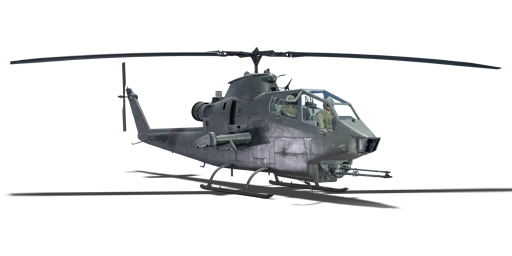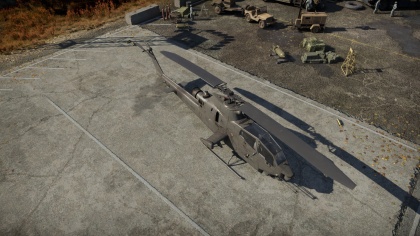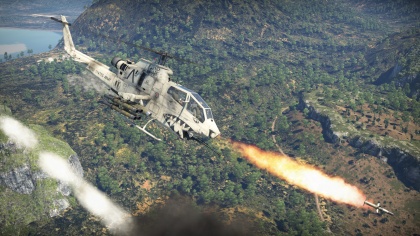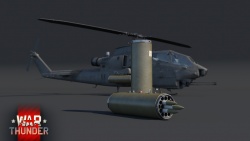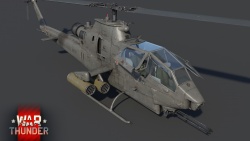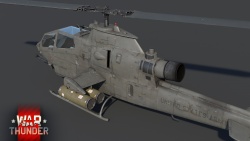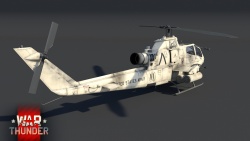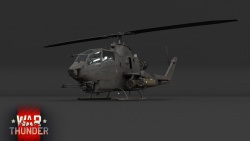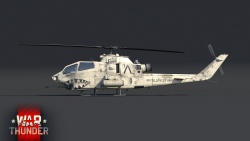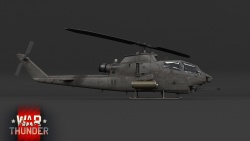Difference between revisions of "AH-1F"
m (→Pros and cons) (Tag: Visual edit) |
(→History) (Tag: Visual edit) |
||
| Line 187: | Line 187: | ||
== History == | == History == | ||
| − | + | The U.S. Marine Corps was interested in the Cobra and ordered an improved twin-engined version in 1968 under the designation AH-1J. This would lead to more twin-engine variants. In 1972, the Army sought improved anti-armor capability. Under the Improved Cobra Armament Program (ICAP), trials of eight AH-1s fitted with TOW missiles were conducted in October 1973. After passing qualification tests the following year, Bell was contracted with upgrading 101 AH-1Gs to the TOW-capable AH-1Q configuration. Following AH-1Q operational tests, a more powerful T53 engine and transmission were added from 1976 resulting in the AH-1S version. The AH-1S was upgraded in three steps, culminating with the AH-1F. | |
| + | |||
| + | In total, there were 143 production aircraft and 387 converted AH-1G Cobras. The AH-1F incorporates all Step 1 and 2 upgrades to the AH-1S. It also featured Step 3 upgrades: a head-up display, a laser rangefinder, an infrared jammer mounted above the engine exhaust, and an infrared suppressing engine exhaust system, and the M143 Air Data Subsystem (ADS). The AH-1F is also referred to as the "Modernized AH-1S", "AH-1S Modernized Cobra", or "AH-1S(MC)" prior to 1988.<ref>Bishop, Chris. ''Huey Cobra Gunships''. Oxford, UK: Osprey Publishing Limited, 2006. <nowiki>ISBN 1-84176-984-3</nowiki>.</ref> | ||
| + | |||
| + | This variant served with the US Army until it became replaced by the AH-64 Apache, and with the USMC years after that, even being present in conflicts like the Gulf War in 1991. The U.S. Army phased out the AH-1 during the 1990s and retired the AH-1 from active service in March 1999, offering them to NATO allies. The Army retired the AH-1 from reserves in September 2001. The retired AH-1s have been passed to other nations and to the USDA Forest Service. | ||
== Media == | == Media == | ||
Revision as of 20:15, 6 December 2019
Contents
| This page is about the American attack helicopter AH-1F. For other uses, see AH-1 (Family). |
Description
The AH-1F is a rank VI American attack helicopter
with a battle rating of 9.7 (AB/RB/SB). This helicopter was introduced in Update 1.81 "The Valkyries".
General info
Flight Performance
The AH-1F is a single turboshaft T53-L-703 power plant, it provides up to 1300 BHP & 210 Kgf with a mass of 350 Kg. This turboshaft engine is able to push the AH-1F to speeds in excess of 277 km/h whilst carrying wing mounted armaments.
| Characteristics | |||
|---|---|---|---|
| Stock | |||
| Max Speed (km/h at 1,000 m) |
Max altitude (meters) | ||
| AB | RB | ||
| 266 | 259 | 3475 | |
| Upgraded | |||
| Max Speed (km/h at 1,000 m) |
Max altitude (meters) | ||
| AB | RB | ||
| 288 | 277 | 3475 | |
Survivability and armour
The AH-1F is an armoured attack helicopter offering protection to the crew and engine:
- Composite boron carbide seat enclosures, for both of the crew, with a thickness of 20 mm.
- A steel seat, which offers a thickness of 12 mm for the pilot only.
- Steel plate covers, offering 12 mm of thickness over the turboshaft engine.
The AH-1F compensates with its small and nimble size compared to the Mi-24 Hind's which are incredibly well armoured but are huge and slow in comparison. However, the AH-1F does not protect all of its critical components, such as: fuel tanks, transmission, propeller shaft & control surfaces with armour plating. Nor does it have armoured glass installed around the cockpit.
Armaments
Offensive armament
The AH-1F is armed with:
- 1 x 20 mm M197 cannon (750 rpg = 750 total)
Suspended armament
The AH-1F offers a wide range of choice for secondary armament, up to 12 choices:
- Without load
- 28 x FFAR Mighty Mouse rockets
- 76 x FFAR Mighty Mouse rockets
- 2 x 7.62 mm M134 Minigun machine gun
- 2 x 7.62 mm M134 Minigun machine gun & 14 x FFAR Mighty Mouse rockets
- 2 x 7.62 mm M134 Minigun machine gun & 38 x FFAR Mighty Mouse rockets
- 4 x BGM-71 TOW missiles
- 4 x BGM-71 TOW missiles & 2 x 7.62 mm M134 Minigun machine gun
- 4 x BGM-71 TOW missiles & 38 x FFAR Mighty Mouse rockets
- 8 x BGM-71 TOW missiles
- 8 x BGM-71 TOW missiles & 38 x FFAR Mighty Mouse rockets
- 8 x BGM-71 TOW missiles & 2 x 7.62 mm M134 Minigun machine gun
Usage in battles
When playing the AH-1F, select the helipad which is in the ideal tactical location for your playstyle. Climb to around 1500 meters, find a target, then descend on to them. It is critically important that you engage them from the rear of side. This way, it reduces their awareness of you, since they will be looking forward, this will help you by making the adversary become disoriented when attacked. This will give you a stealthy advantage, like a ninja. Advancing onto the target, come in as fast as possible, then slow down quickly, by raising the noise of the helicopter up. When slowed down, Engage the sight stabilizer and fire the tow missile and guide it onto the target.
If the target starts moving, rolling or starts trying to evade, keep the missile on the target and adjust to what your adversary is doing. Until you see an explosion, the target going down in flames whilst the reward and notification are showing up.
If out of the range, the missile will self-detonate and could give your position away, if your adversary looks around.
| Remember you only have around one and a half miles before the missiles will denote by them self, you can only select to carry either 4 or 8 BG-71 Tow missiles. |
To overcome this, with enough time spent playing with the BG-71 missiles, you will be able to determine when you are within range based on your experience. This also applies to any other type of missile in the game too.
When engaging in Close quarters combat with other helicopters, the biggest threats are air-to-air missiles. Since the AH-1F only offers limited protection against them with countermeasures with its IRCM module. This means you need to stay alert, active & on the lookout for fast moving dots. If you see a small fast dot heading towards you, make very sharp abrupt turns, change height at the same time while turning and rolling.
| These are the biggest threats to you in battle, since they can carry air-to-air missiles |
- AH-1Z Viper
- Mi-24P Hind
- Mi-24V Hind
- Mi-35M
- Ka-50
- SA.341F Gazelle
- SA.342M Gazelle
- EC-665 Tiger HAD
- EC-665 Tiger HAP
- EC-665 Tiger UHT
| You may even be able to shoot down missiles with the installed 20 mm triple rotary M197 cannon. |
When engaging other helicopters, the triple barrel rotary cannon makes short work of any adversary. Make sure to load it with the air target belt, aim for critical elements of the rival helicopters such as cockpit, engine and fuel tanks. Now if you have equipped your helicopter with the additional 2 x M134 miniguns 7.62 mm machine guns, Bring your target in front of you and open fire. They will obliterate the target and send it smoking to the ground, they have up to 3000 rounds in total. That’s 1,500 Rounds per mini gun, in addition to the 750 cannon rounds for the M197, that is potentially up to 3,750 rounds!
Ground forces
Playing the AH-1F in ground forces, it is recommended to load up the 8x BG-71 Tow missiles & 38x FFAR Might mouse missiles. The BG-71 will give you the penetration at range in order to terminate tankers and with safety from the Anti-Aircraft Missile equipped anti-air vehicles. It is a wise tactic that Anti-Aircraft Missile equipped anti-air vehicles to be terminated first. Then once terminated, move into the battlefield and dominate the tanks with the 38 x FFAR Might mouse missiles, which can cause a lot of damage and could potentially terminate up to 38 tanks with well-placed shots.
The ideal tactic is to utilise the helicopter and the terrain. Such as maps which have forests and lots of tree lines, stay low over the trees and select your targets based on the threat to yourself first, then the impact to the team.
For example, if you have seen no enemy SPAA vehicles or other helicopters, climb in height, hover, then fire one or two missiles. Then quickly break off the hover and move to another part of the map, this way it allows you to stay undetected, remain stealthy and become a major threat to the enemy team.
Handling radar and Surface to Air missiles, when an enemy missile equipped SPAA is achieving a lock on, you will be notified with red arrows on the screen saying radar. To break the lock start rolling, gaining speed and the arrows will go away. If you are not successful, keep a close watch around the helicopter. At this, you will see white smoke coming from the ground, make very sharp abrupt turns. Change height at the same time while turning and rolling to avoid the missile.
| Keep a close watch out for airplanes and other attack helicopters! |
Modules
| Tier | Flight performance | Survivability | Weaponry | |||
|---|---|---|---|---|---|---|
| I | Compressor | Flack jacket | Offensive 20 mm belts | |||
| II | Helicopter frame | New 20 mm cannons | M261 | IRCM | ||
| III | Engine | Replacing helicopter blades | Gun pod XM-18 | TOW | ||
| IV | Cover | New 7 mm MGs | TOW 4 | |||
Pros and cons
Pros:
- 20 mm gun performs better against heavy armour than the 7.62 mm minigun.
- Great manoeuvrability
- Very agile, with secondary load outs installed
- Great acceleration, very quick
- Good secondary weapon loadout
Cons:
- No flairs
- No sidewinder Air-to-Air missiles
- 3 km range on it's AGMs
History
The U.S. Marine Corps was interested in the Cobra and ordered an improved twin-engined version in 1968 under the designation AH-1J. This would lead to more twin-engine variants. In 1972, the Army sought improved anti-armor capability. Under the Improved Cobra Armament Program (ICAP), trials of eight AH-1s fitted with TOW missiles were conducted in October 1973. After passing qualification tests the following year, Bell was contracted with upgrading 101 AH-1Gs to the TOW-capable AH-1Q configuration. Following AH-1Q operational tests, a more powerful T53 engine and transmission were added from 1976 resulting in the AH-1S version. The AH-1S was upgraded in three steps, culminating with the AH-1F.
In total, there were 143 production aircraft and 387 converted AH-1G Cobras. The AH-1F incorporates all Step 1 and 2 upgrades to the AH-1S. It also featured Step 3 upgrades: a head-up display, a laser rangefinder, an infrared jammer mounted above the engine exhaust, and an infrared suppressing engine exhaust system, and the M143 Air Data Subsystem (ADS). The AH-1F is also referred to as the "Modernized AH-1S", "AH-1S Modernized Cobra", or "AH-1S(MC)" prior to 1988.[1]
This variant served with the US Army until it became replaced by the AH-64 Apache, and with the USMC years after that, even being present in conflicts like the Gulf War in 1991. The U.S. Army phased out the AH-1 during the 1990s and retired the AH-1 from active service in March 1999, offering them to NATO allies. The Army retired the AH-1 from reserves in September 2001. The retired AH-1s have been passed to other nations and to the USDA Forest Service.
Media
- Images
- Skins
See also
- Related development
- Aircraft of comparable role, configuration and era
- Agusta A129 Mangusta
External links
| USA helicopters | |
|---|---|
| Attack | |
| Black Hawk | MH-60L DAP |
| Choctaw | H-34 |
| Cobra | AH-1F · AH-1G · AH-1Z |
| SuperCobra | AH-1W |
| Kiowa | OH-58D |
| Little Bird | AH-6M |
| Apache | YAH-64 · AH-64A · ▃AH-64A Peten · AH-64A (GR) · AH-64D |
| Utility | |
| Huey | UH-1B · UH-1C · UH-1C XM-30 |
- ↑ Bishop, Chris. Huey Cobra Gunships. Oxford, UK: Osprey Publishing Limited, 2006. ISBN 1-84176-984-3.


